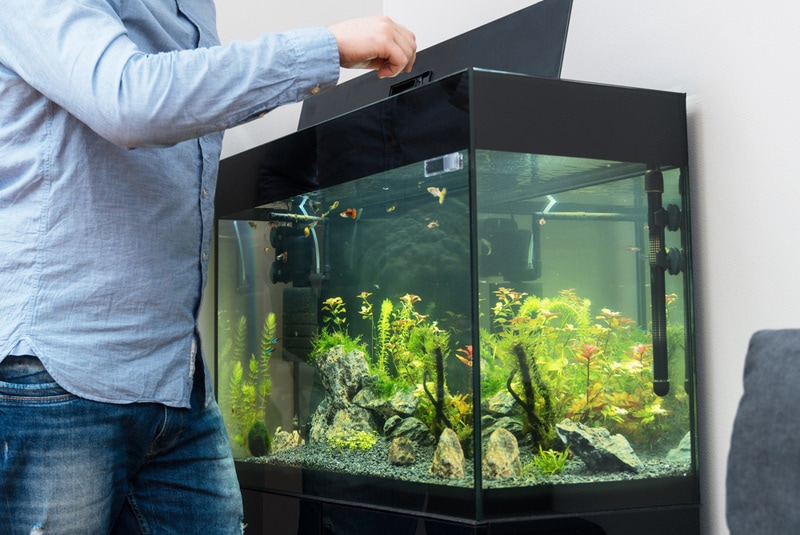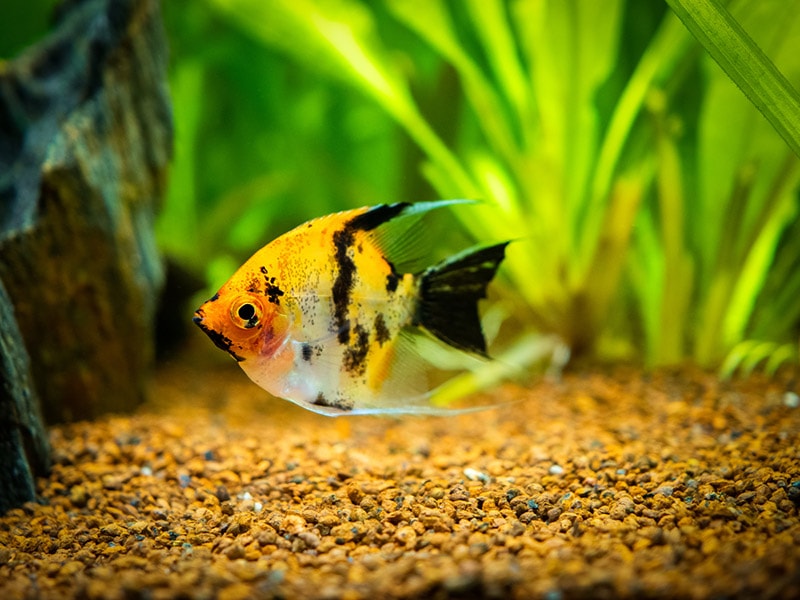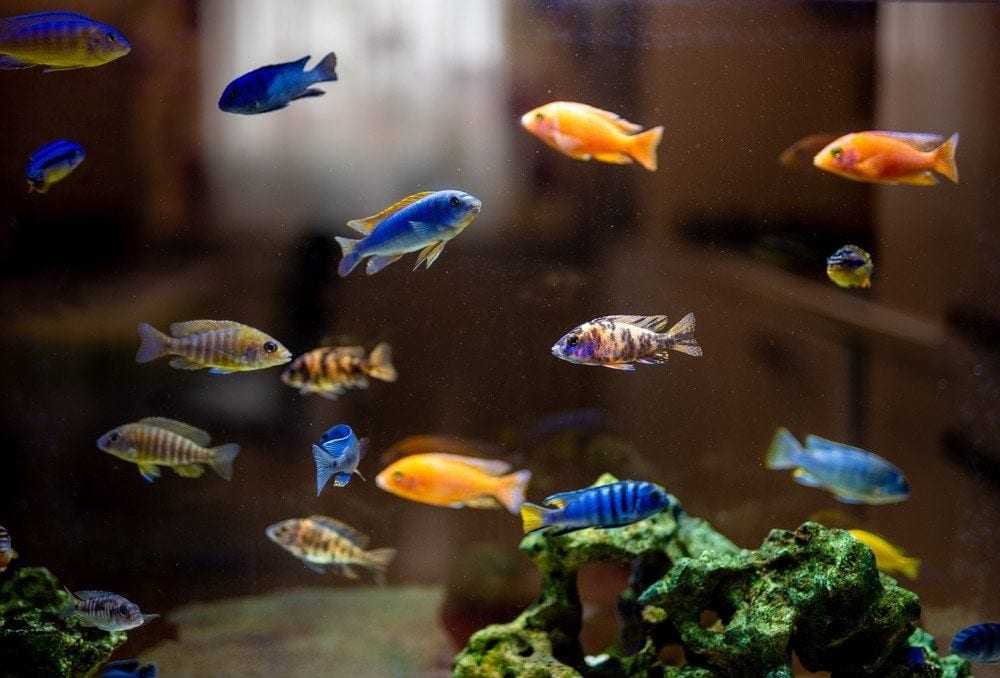How Much Does a 20-Gallon Fish Tank Weigh (Vet-Verified Aquarium Size & Weight Guide)
Updated on

Click to Skip Ahead
Each gallon of water weighs around 8.34 pounds. Therefore, you can guess the weight of 20 gallons of water pretty easily. 20 times 8.34 is around 166.8 pounds (75.7 kg). However, that doesn’t count any of the actual tank’s weight. Sadly, this is where things get a little bit complicated. Different types of tanks weigh different amounts, as their material will differ in weight.
Read on below to find out more.
Fish Tank Variables
Glass weighs much more than acrylic, for instance. A glass tank may weigh around 24 pounds by itself, while an acrylic tank weighs around 15 pounds. Therefore, your tank could be about 10 pounds heavier or lighter, depending on the material.
In total, a filled glass tank would weigh around 192 pounds, while a filled acrylic tank would weigh around 182 pounds.
Of course, these are just estimates. The actual weight of a tank will depend on the exact tank. Some may be heavier than others, which can add a few more pounds. Generally, though, a filled 20-gallon tank will weigh just under 200 pounds.
Here’s how that compares to other common tank sizes:
| Tank Size (Gallons) | Weight of Water |
| 10 | 83.4 pounds (37.8 kg) |
| 20 | 166.8 pounds (75.7 kg) |
| 30 | 250.2 pounds (113.5 kg) |
| 40 | 333.6 pounds (75.7 kg) |
| 55 | 456.7 pounds (151.3 kg) |
| 75 | 625.5 pounds (283.7 kg) |
| 100 | 834 pounds (378.3 kg) |
| 125 | 1,042.5 pounds (472.9 kg) |
What About Decorations and Substrate?
When you fill a tank, you aren’t just adding water. Therefore, the weights above won’t be 100% accurate for your particular tank. For the substrate and decorations, you add water. Substrate can be particularly heavy, and you may add more or less depending on your needs. Some fish require more substrate, as they may like to burrow. Others may not need any substrate. The weight is obviously going to change depending on these decisions.
Plants typically do not weigh very much. However, lots of them absolutely do. If you have a jungle-like tank, you can expect that the tank will be much heavier than one that is mostly empty.
Decorations can also get very heavy very fast. Driftwood is a popular decorative element, but pieces of real driftwood can be very heavy. Cement decorations and rocks can also be fairly heavy. One single decorative element may not weigh very much, but when you’re using 10, you can expect things to get heavy pretty fast.

What About the Equipment?
You are going to be using a lot of equipment with your tank, too. All of these can make your whole fish tank heavier, as they can add up fast. It’s important to consider all of these extra components when deciding if a stand can support your tank or not.
For instance, the weight of the filter can vary depending on the type. Some may weigh more than 3 pounds if they have a larger motor and are more powerful. A small bubble filter may not even weigh 1 pound. A heater usually won’t weigh a pound either. However, if you have a larger filter because you need the water a lot warmer than your air temperature, then you can expect it to weigh a pound or so.
An air pump will probably weigh around 0.5 pounds. The lighting system can weigh a lot if you have a very fancy one. Even a smaller one will weigh at least a pound, while a larger one may weigh 5. Remember, many fish and plants need UVB light. Sometimes, you may need separate light fixtures for UVB and visible light.
To estimate the full weight of a fish tank, be sure to include the weight of the equipment you plan on using. Most manufacturers will include the weight of each item on their website, allowing you to accurately measure how heavy everything would be together.
If you’re checking your floor strength, be sure to include the weight of the stand or piece of furniture, as well. A sturdy stand may easily weigh just as much as the tank itself (if not more). Therefore, in areas with weaker floors, the stand may make or break putting a tank on the upper floor of your house.

How Do You Support the Weight of a Filled Aquarium?
You need to be fairly cautious about where you put a filled 20-gallon tank. While most steady pieces of furniture should be able to support this weight, there are many things that won’t. When in doubt, it’s best to get a stand that is made for an aquarium. Obviously, the creators of these stands made them to hold up a heavy tank.
Even if you don’t purchase a separate stand, ensure the furniture you use is sturdy and made of strong materials. A bookcase or similar piece of furniture likely won’t work. However, a dresser or a desk might. You should check the weight limit of the piece of furniture you plan on using, if it is available. Most ready-made stands have these weight limits, but other pieces of furniture may not.
The surface also needs to be very flat and level. Otherwise, the water may not be even, which can cause all sorts of problems. It can also make part of the tank heavier than the others, putting more strain on certain pieces of the stand. This may cause holes or dents, making the surface even less even. When possible, use a level to ensure that the tank is sitting evenly on the stand.
You may also want to consider the floor strength, especially on the upper floors. Some floors may need extra reinforcement or support to handle the load of a filled aquarium. Luckily, this is less of a problem with 20-gallon tanks, as they aren’t much heavier than some pieces of furniture.
Don’t let the tank hang over the edges of the stand. It should be fully supported. If it’s off the edge, the parts that are on the stand may be heavier, causing issues. Plus, it increases the chance that your tank will fall over.
When you fill up your tank, you should also check the stand for signs of wear and damage. It’s essential to catch and address any issues early to prevent the stand from breaking and the tank falling.

What Are the Dimensions of a Standard 20-gallon Tank?
The dimensions of a tank can vary depending on the exact type of tank. Some are very tall, while others are horizontal. Often, horizontal tanks are easier to support as they spread the weight out more. However, it can be harder to find a stand long enough. On the other hand, taller tanks concentrate the weight in one particular area, which can be an issue. The “standard” measurements though, as are follows:
A 20-gallon fish tank can weigh around 200 pounds, depending on the exact material the tank is made out of. Glass can be much heavier than acrylic or other materials. You also have to consider the décor and equipment, though, which can easily weigh over 20 pounds. Therefore, it isn’t odd for a 20-gallon fish tank to be over 200 pounds once it’s all set up. Luckily, fish themselves don’t tend to weigh very much (especially those that will fit in a 20-gallon fish tank). Therefore, you don’t have to worry about the weight of the fish. You can safely use them out of your calculations. It’s often best to purchase a fish tank stand that’s made for a 20-gallon tank. These are made to support the full weight of a fish tank. However, other pieces of furniture can also be used if they are strong and sturdy enough. Featured Image Credit: M-Production, Shutterstock
Tank Type
Length (Inches)
Depth (Inches)
Height (Inches)
20 Gallon Long
30
12
12
20 Gallon High
24
12
16
20 Gallon x-High
20
10
24
20 Gallon Hex
18
13
20
Conclusion












